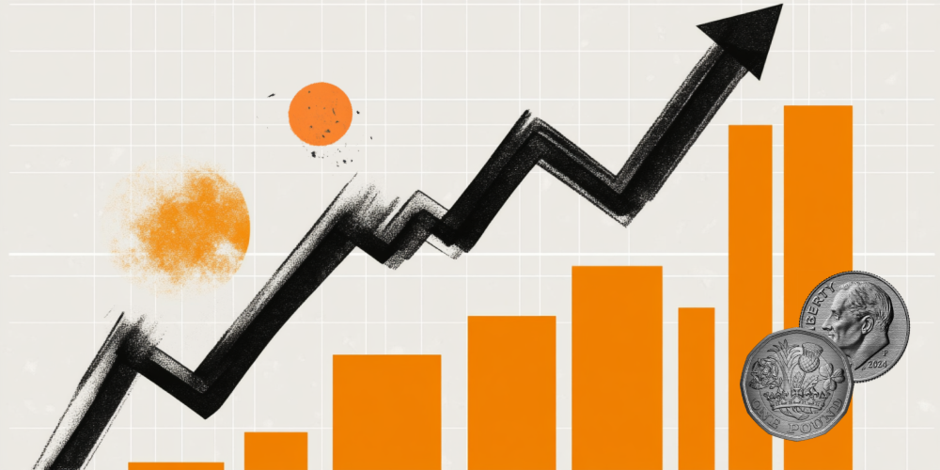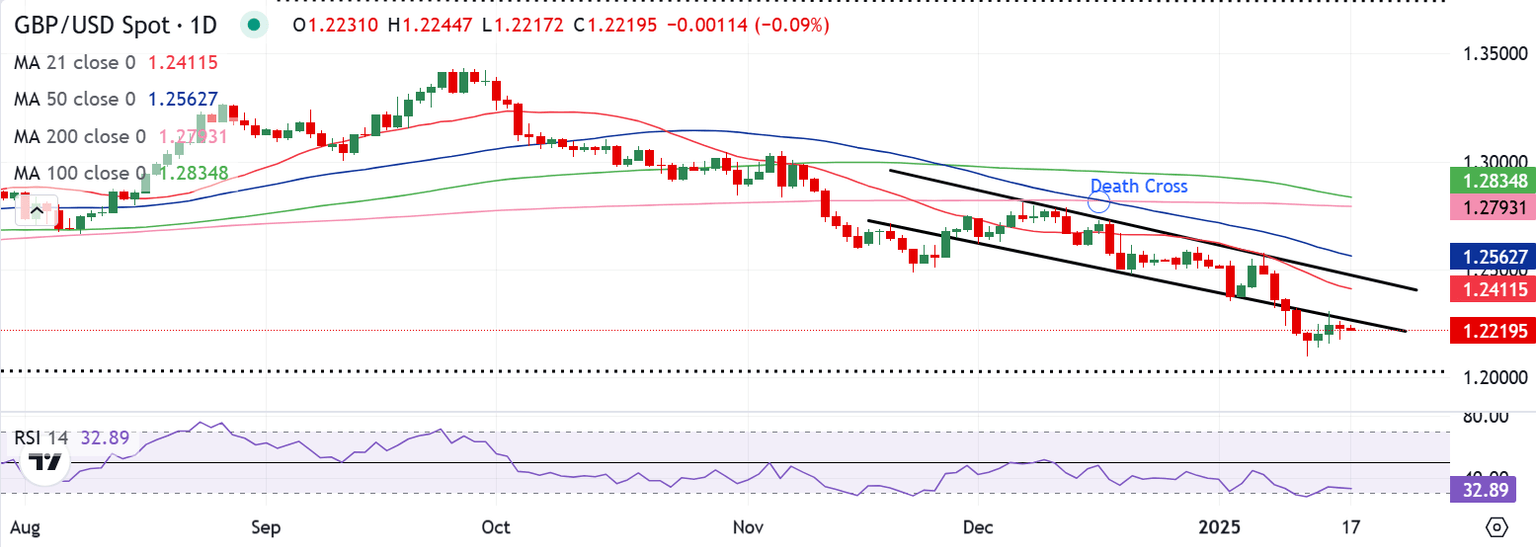GBP/USD Weekly Outlook: US President Trump means fresh challenges for Pound Sterling
- The Pound Sterling recovered from 14-month lows of 1.2100 versus the US Dollar.
- GBP/USD braces for Trump 2.0, UK labor data and global preliminary PMI reports.
- Technically, the pair looks vulnerable as the daily RSI remains bearish.

The Pound Sterling (GBP) paused its downtrend against the US Dollar (USD), fuelling a tepid GBP/USD recovery from 14-month lows of 1.2100.
Pound Sterling bounced on US Dollar correction
This week, it was all about the inflation data from the United Kingdom (UK) and the United States (US). However, the US inflation data-led renewed dovish expectations surrounding the Federal Reserve (Fed) fuelled a sustained correction in the USD and the US Treasury bond yields from over one-year highs. The broad US Dollar softness allowed the GBP/USD pair to sigh relief after hitting a fresh 14-month low at 1.2100 to begin the week.
Earlier in the week, the US Consumer Price Index (CPI) rose in line with estimates at an annual rate of 2.9% in December from November's 2.7%. However, core CPI, which excludes food and energy prices, rose by 3.2%, below forecasts of 3.3%. Meanwhile, the US annual Producer Price Index (PPI) rose 3.3% in December, missing the expected 3.4% growth.
Tame US inflation figures revived expectations that the Fed would remain on track for two interest rate cuts this year. Markets now predict the Fed will deliver 37 basis points (bps) worth of rate cuts by year-end, compared with about 30 bps before the inflation data. Dovish commentaries from the Fed policymakers also contributed to markets piling up on Fed rate cut bets.
However, the GBP/USD recovery faced headwinds from increased bets of interest rate cuts by the Bank of England (BoE) this year, courtesy of the surprise UK inflation cooldown and weak Retail Sales data for December. The UK annual CPI rose 2.5% in the year to December, down from 2.6% the month before, the Office for National Statistics (ONS) said, missing the estimated 2.7% growth. Services inflation declined sharply to 4.4% YoY in December from November’s 5%.
The ONS said on Friday that British Retail Sales, adjusted for the inclusion of the Black Friday sales at the start of the month, fell by 0.3% in month-on-month (MoM) in December after a downwardly revised 0.1% expansion in November.
Further, investors’ nervousness before US President-elect Donald Trump’s inauguration on Monday, January 20, negatively affected the risk-sensitive Pound Sterling. Concerns over the impact of Trump’s potential policies on inflation and the economy remained as an underlying drag on broader market sentiment.
Week ahead: Trump returns to the White House
GBP/USD traders are preparing for a critical week as US President-elect Donald Trump returns to the White House, inaugurating his second term on Monday.
Trump’s policy announcements will be closely scrutinized as they will have a lasting impact on broader market sentiment and risk-sensitive assets such as the Pound Sterling.
Though it will be a holiday-shortened week, it is anticipated to be more volatile. US markets will remain closed on Monday in observance of Martin Luther King Jr. Day.
Tuesday will feature only the UK employment data, while there will be no top-tier economic data releases from either side of the Atlantic on Wednesday.
Therefore, attention will turn to the US weekly Jobless Claims data due on Thursday ahead of Friday’s S&P Global preliminary UK and US Manufacturing and Services PMI data.
The annual World Economic Forum (WEF) meetings will remain in the spotlight alongside data publication. The event will be held in Davos from January 20 to 24 and will be attended by several global leaders, including central bankers, heads of state, and business leaders.
It’s worth noting that there will be no public appearances from Fed policymakers as they enter the ‘blackout period’ on Saturday ahead of the January 28-29 policy meeting.
GBP/USD: Technical Outlook

The daily chart shows that GBP/USD sellers hold the downside break from the six-week-long falling wedge formation confirmed a week ago.
The 14-day Relative Strength Index (RSI) has bounced off the oversold region but remains below the midline, currently near 33. The leading indicator suggests that any rebound in the major is likely to be met with a strong supply force.
Adding credence to the bearish potential, the 100-day Simple Moving Average (SMA) is approaching the 200-day SMA from above. If the 100-day SMA pierces through the latter to the downside on a daily closing basis, a Bear Cross could be validated.
If sellers regain poise, the pair could revisit the 14-month low of 1.2100 before further downside opens up toward the 1.2050 psychological level and the October 2023 low of 1.2037.
A sustained break below that level will trigger a fresh downtrend toward the 1.1900 level.
Conversely, acceptance above the 21-day SMA at 1.2411 is critical to initiate a meaningful recovery toward the 50-day SMA at 1.2562.
Ahead of that, the upper boundary of the wedge at 1.2487 could challenge the bearish commitments.
Pound Sterling FAQs
The Pound Sterling (GBP) is the oldest currency in the world (886 AD) and the official currency of the United Kingdom. It is the fourth most traded unit for foreign exchange (FX) in the world, accounting for 12% of all transactions, averaging $630 billion a day, according to 2022 data. Its key trading pairs are GBP/USD, also known as ‘Cable’, which accounts for 11% of FX, GBP/JPY, or the ‘Dragon’ as it is known by traders (3%), and EUR/GBP (2%). The Pound Sterling is issued by the Bank of England (BoE).
The single most important factor influencing the value of the Pound Sterling is monetary policy decided by the Bank of England. The BoE bases its decisions on whether it has achieved its primary goal of “price stability” – a steady inflation rate of around 2%. Its primary tool for achieving this is the adjustment of interest rates. When inflation is too high, the BoE will try to rein it in by raising interest rates, making it more expensive for people and businesses to access credit. This is generally positive for GBP, as higher interest rates make the UK a more attractive place for global investors to park their money. When inflation falls too low it is a sign economic growth is slowing. In this scenario, the BoE will consider lowering interest rates to cheapen credit so businesses will borrow more to invest in growth-generating projects.
Data releases gauge the health of the economy and can impact the value of the Pound Sterling. Indicators such as GDP, Manufacturing and Services PMIs, and employment can all influence the direction of the GBP. A strong economy is good for Sterling. Not only does it attract more foreign investment but it may encourage the BoE to put up interest rates, which will directly strengthen GBP. Otherwise, if economic data is weak, the Pound Sterling is likely to fall.
Another significant data release for the Pound Sterling is the Trade Balance. This indicator measures the difference between what a country earns from its exports and what it spends on imports over a given period. If a country produces highly sought-after exports, its currency will benefit purely from the extra demand created from foreign buyers seeking to purchase these goods. Therefore, a positive net Trade Balance strengthens a currency and vice versa for a negative balance.
Economic Indicator
Employment Change (3M)
Employment Change released by the UK Office for National Statistics represents the change in the number of people who were employed in the UK in the three months to the release period. Generally, a healthy and consistent increase of this figure is seen as bullish for the Pound Sterling (GBP), while a decrease is seen as bearish.
Read more.Next release: Tue Jan 21, 2025 07:00
Frequency: Monthly
Consensus: -
Previous: 173K
Source: Office for National Statistics
Premium
You have reached your limit of 3 free articles for this month.
Start your subscription and get access to all our original articles.
Author

Dhwani Mehta
FXStreet
Residing in Mumbai (India), Dhwani is a Senior Analyst and Manager of the Asian session at FXStreet. She has over 10 years of experience in analyzing and covering the global financial markets, with specialization in Forex and commodities markets.

















